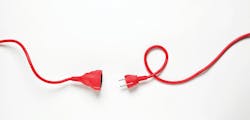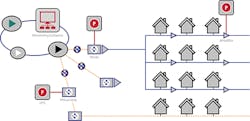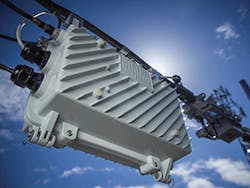Small Cells Unplugged
From ISE magazine to the Wall Street Journal, small cells are the headline-grabbing technology that is transforming wireless networks. Outdoor small cells are used to provide network densification, which means adding more cell sites to increase network capacity, as well as coverage in areas not reached effectively by macro cells such as urban canyons. While small cells are useful tools for 4G/LTE networks, they are absolutely essential for 5G and its requirements for ultra-low latency. However, since these small cell devices are placed closer to the end users and further away from the base station or the mobile switching center, deployment is not always straightforward.
Backhaul is one of the primary considerations for placing small cells, though it is often easier to resolve due to the abundance of fiber optic and coaxial cables. A bigger issue is siting and permitting, time-consuming activities that often encounter delays due to objections from municipalities, historical preservation societies, and, lately, consumers and politicians concerned with the impact of radio frequencies on health. Despite these issues, small cell deployment is proceeding, albeit at a slower pace than forecasted. Still, even after the method of backhaul is defined and siting is approved, the network provider must deal with another, often under-the-radar issue: how to power the small cell.
InvisiLight® Solution for Deploying Fiber
April 2, 2022Go to Market Faster. Speed up Network Deployment
April 2, 2022Episode 10: Fiber Optic Closure Specs Explained…
April 1, 2022Food for Thought from Our 2022 ICT Visionaries
April 1, 2022Why is power the forgotten requirement? It is normal to assume electricity is available wherever needed. After all, the electrical grid covers virtually all of the inhabited space in North America.
But access to the grid is not always readily available. To get commercial power to the site, the area’s utility may need to run a drop cable and possibly install a meter and disconnect. Utility projects can be expensive and time-consuming, perhaps jeopardizing the business case and deployment timelines.
Thankfully, an alternative to local commercial power, a technique referred to as remote power, delivers electricity over telecommunications or cable TV cables from a centralized power source to the small cell site.
Remote power is generally divided into 2 categories:
1. Remote Power Over Twisted Pair, or
2. Remote Power Over Coax.
Both techniques include a centralized power source that accesses the electrical grid. The grid power is converted and delivered over the copper cables to multiple small cell sites. There, the power is converted to the right voltage to operate the small cell
Remote Power Over Twisted Pair
The remote power technique that uses twisted pair OSP cable is called Remote Line Power (RLP), though some refer to it as network power, span power, or remote network power. With RLP, the primary power source may be in a central office or, more likely, a power cabinet located in the OSP network. In either case, a rectifier plant converts utility AC power to -48Vdc which is fed to an upconverter, a special DCDC converter that increases the voltage to ±190Vdc for delivery over the copper pairs. The elevated voltage minimizes the current delivered over the pairs, resulting in lower I2R losses in the cable and extending the reach for the power equipment. At the far end, the elevated voltage is converted back to the voltage required by the remote device using another special DCDC converter called a downconverter.
Figure 1. Aerial Remote Power Downconverter Installation
The upconverter is typically a modular, shelf-based unit that operates in a controlled environment. The downconverter is deployed in the harsh OSP environment, so it is normally a standalone, sealed unit that can be mounted on a strand, a pole, or a wall near the small cell radio. A typical aerial installation is shown in Figure 1.
Variations of Remote Line Power have been used for decades. From T1 cables and paystation coin return signals to Fiber-to-the-Node and Fiber-to-the-Home and now G.fast, twisted pair cables have proven to be a viable means of remote power. Small cells are the latest candidate with a Southern California installation including 14,000+ remotely powered small cells. Similar powering techniques are scheduled for over a dozen other US cities.
Remote Power Over Coax
Cable MSOs provide power over coax using a network architecture called Hybrid Fiber Coax (HFC). This method uses a fiber optic backbone to distribute the signals from the Head End location to the Optical Nodes (as shown in Figure 2). The Optical Nodes convert the inbound light signals (forward) to RF energy and return RF signals to light. The RF signal from the Optical Node is then distributed to homes and businesses through coaxial cables.
Figure 2. HFC Network Diagram
At the Optical Node, power is inserted into the coaxial cable to energize downstream devices such as amplifiers. The low frequency 60Hz power is provided using a power supply unit and a power inserter spliced into the coaxial distribution cable, combining electrical power with the forward and return RF signals. Typically, the power is inserted along the length of the coaxial cable, with each power supply providing up to 15 Amps.
Figure 3. Aerial HFC Gateway Installation
There is ample power available for small cells in addition to the regular cable network devices. To connect the small cells to the coax, a gateway device is inserted into the coax path. The gateway converts the voltage on the coax (typically, 89Vac or 120Vac) into the right voltage to energize the small cell. These sealed gateway devices are typically mounted on a strand (as shown in Figure 3), but can also be placed in a handhole.
HFC networks offer an additional benefit. When enabled to meet Data Over Cable Service Interface Specification (DOCSIS), a standard that allows for the addition of high-bandwidth data transfer to an existing coaxial cable TV system, these HFC networks not only provide power, but also backhaul, eliminating the need for a separate fiber cable.
Remote power over coax is already a viable solution for powering small cells. This technique has already been used to connect over 19,000 small cell radios in the Northeast, with several other trials and deployments underway. According to NCTA, HFC networks pass 90% of the homes in the US. It stands to reason that these HFC networks will be available for powering small cells.
Dollars and Sense
On the surface, remote power seems like a suitable solution for small cells. But is it affordable, and does it make sense?
Like all OSP applications, the specifics of the site dictate the solution. For example, if a municipality allows a service provider to place its small cells on light poles where a usable source of electricity is present, then commercial power is a no-brainer. Simply connect an AC-powered small cell to the light pole’s electricity source.
However, many municipalities prevent placement on light poles due to aesthetic concerns. When they do allow it, they expect to be richly compensated for access. On top of that, the electricity may not be available 24/7 since the lights operate only at night.
Since light poles are not the answer, the network provider is usually faced with a power decision: pay for the utility to construct a connection to the grid, or find a remote power solution. Since the cost of connecting to the utility grid can range from thousands to tens of thousands of dollars, many service providers look to the remote power option.
• When the MSO or Telco has existing cable present, remote power avoids the utility construction cost.
• Installation costs are low because the powering device can be connected to existing cables quickly with a single truck roll.
• Operational expenses are minimized by locating the power device on the strand or in a handhole, eliminating costly and recurring pole attachment fees.
• Maintenance truck rolls can be reduced by remotely accessing the power device to reset a small cell radio by toggling the power on and off.
• In the future, when backup power is required to meet the requirements for autonomous vehicles and other new services, upgrading the central power source is much quicker and less expensive than adding a backup power cabinet at each small cell site.
Here is where "sense" enters the discussion. If a service provider — either MSO or Telco — is passing the small cell site and has available capacity, it seems logical to re-purpose their network to provide power or, in the case of the MSO, power and backhaul. There are examples of MSOs providing access to a wireless service provider, but not yet on a widespread basis. When they roll out CBRS, they are expected to use their embedded HFC networks. Generating additional revenues for powering and/or backhauling other wireless providers seems like a natural extension of their networks’ capabilities.
For Telcos, wireless substitution has freed up plenty of spare telephone cable pairs. While these pairs could be used to power small cell devices, Telcos have not yet engaged in powering a 3rd party small cell network. There may be concerns with cable quality, though there are engineering practices to ensure the copper plant is suitable. Or perhaps it’s due to the impact on accounting methods, or even a liability issue. Regardless, the re-purposing of twisted pair communications cables into power cables for small cells has not yet taken off.
In an interesting turn of events, however, some network builders have embraced the Remote Line Power concepts and are deploying new twisted pair cables to supply power to the small cell site. The cables are often deployed alongside fiber backhaul cables, minimizing the installation cost.
In supplying their own power cables, the network builders gain better control of their deployment schedules, eliminating dependency on the electrical utility or the communications service provider. And because the copper cables are relatively inexpensive, the network builders still enjoy a favorable financial result using remote power.
Conclusion
Remote power was once considered a stopgap solution for when local power was difficult or expensive to obtain. Now, with tens of thousands of remotely powered small cells in North America, remote power has become mainstream. The small cell network builders benefit from lower total cost of ownership. The installed first cost is favorable, and the operational savings can be significant. Perhaps an even more important driver is the ability to control schedules and improve time to market.
Communications service providers stand to benefit from the massive deployment of small cells. They have the networks in place along with ample capacity. The key is determining their appetite for working with 3rd party providers, and overcoming existing practices that may prohibit going forward.
Though it may seem that the electrical utilities lose out with remote power, they actually benefit as well. The total amount of power required is similar for either the remote or commercial power methods. But the amount of labor required is dramatically less with remote power, perhaps as much as a 10:1 benefit. It is more feasible to install 400 central power sources than 4,000 small cell sites, especially with a tight timeline.
Remotely powering small cells makes sense. It’s proven, cost-effective, and reliable. And for network builders, communications service providers, and electrical utilities, unplugging small cells can be a win for all parties.
Like this Article?
Subscribe to ISE magazine and start receiving your FREE monthly copy today!
About the Author









